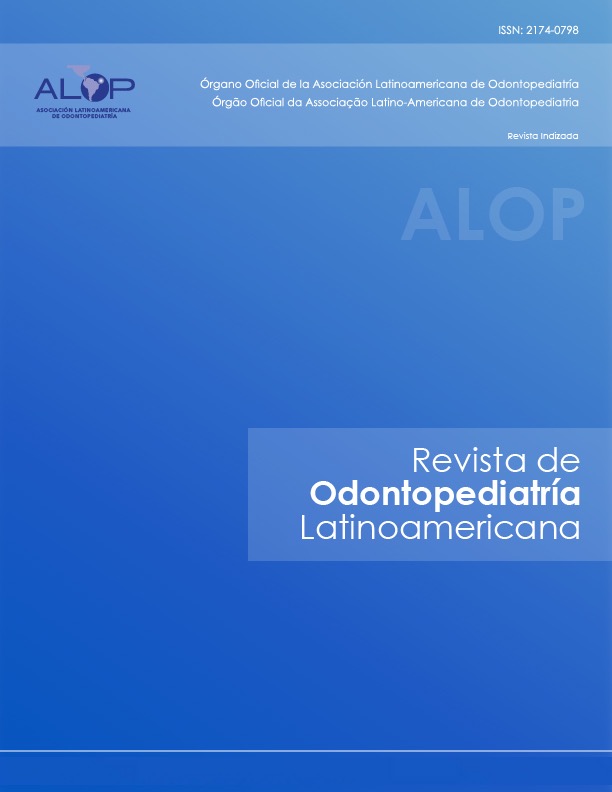Clinical treatment for supernumerary teeth in pediatric patients
DOI:
https://doi.org/10.47990/alop.v2i1.76Keywords:
Supernumerary teeth, prevalence, treatment, pediatric patientsAbstract
Supernumerary teeth (ST) are those formed additionally to the normal dental series. They may be found in any area of the maxilla or mandible with conical, tuberculate o supplementary shape. They may produce occlusal anomalies, and are associated with displacement, eruption disturbances or impaction of adjacent teeth. Objetive: The aim of this study is to describe frequency, associated anomalies and treatment outcome for ST in a group of pediatric patients, from Caracas, Venezuela. Material and methods: 823 orthodontic records (radiographs, photographs) of pediatric orthodontic patients were analyzed. ST shape and location were registered, as well as consequences on adjacent teeth and treatment outcome. Patients with syndromes, systemic disorders or clefts were excluded. Results: Frequency of ST was 5,47%, with male: female ratio of 1.8:1. Mean age at diagnosis was 8.18 (± 1.61). Conical shape was most frequent (45%) and anterior apical area was the most affected (90%). The 73,33% of all patients presented one ST, 22,22% presented two and 4,44% three ST. Displacement of adjacent teeth was observed in 53.3%. Treatment performed included extraction of ST (63.3%) and space for adjacent teeth was gained by expansion and dental arch conformation (87.5%). Spontaneous eruption of adjacent teeth occurred in all but 4 cases, which required orthodontic extrusion. Conclusion: Frequency of ST in this sample was higher than reported in other studies. Treatment outcome was favorable in most cases when extraction of ST and dental arch conformation were performed in the mixed dentition, by multidisciplinary team that included pediatric dentistry and oral surgeon.
References
Chappuzeau E, Cortés D. Anomalías de la Dentición en Desarollo: Agenesias y Supernumerarios. Revista Dental de Chile, 2008; 99 (2): 3-8.
Canut JA. Ortodoncia Clínica y Terapéutica. Segunda edición. España. Editorial Masson. 2000.
Méndez DC, Contreras CC. Anomalías de número en pacientes con dentición mixta. Rev Latinoam Orto Odontoped, Internet 2006: 1-5. Disponible en http://www.ortodoncia.ws/publicaciones/2006/art3.asp
Esenlik E, Özgür Sayin M, Onur Atilla A, Özen T, Altun C, Basak F. Supernumerary teeth in a Turkish population. Am J Orthod Dentofacial Orthop. 2009;136: 848-52.
Calvano E, Gomes A, De Castro Costa M. Rezende A, Granjeiro JM. Supernumerary teeth vary depending on gender. Braz Oral Res. 2011; 25(1):76-9.
Mukhopadhyay S. Mesiodens: A clinical and radiographic study in children. J Ind Soc Pedo Prev Dent, 2011; 29(1): 34-8.
Anthonappa RP, Omer, RSM, King NM. Characteristics of 283 supernumerary teeth in southern Chinese children. Hong Kong. Oral Surg Oral Med Oral Pathol Oral Radiol Endod. 2008; 105(6): e48-54.
Discacciati MS, Lértora MF. Anomalías Dentarias: Prevalencia Observada Clínicamente, en niños de la Ciudad de Corrientes. Argentina. UNIVERSIDAD NACIONAL DEL NORDESTE; Internet 2007, Disponible en http://www.unne.edu. ar/Web/cyt/com2005/3-Medicina/M-028.pdf acceso 6-4-12.
Mevlut C, Hasan K, Hüsamettin O. Prevalence and characteristics of supernumerary teeth in a non-syndrome Turkish population: Associated pathologies and proposed treatment. Med Oral Patol Cir Bucal. 2010; 15(4): e575-8.
Schmuckli R, Lipowski C, Peltomäki T. Prevalence and Morphology of Supernumerary Teeth in the population of a Swiss Community. Schweiz Monatsschr Zahnmed. 2010; 11: 987-90.
Salcido-García JF, Ledesma-Montes C, Hernández-Flores F, Pérez D, Garcés-Ortiz M. Frecuencia de dientes supernumerarios en una población mexicana. Med Oral Patol Oral Cir Bucal. 2004; 9 (5): 403-9.
Rodríguez Romero F, Cerviño Ferradanes S. Múltiples dientes supernumerarios distomolares. Av. Odontoestomatol. 2009; 26(6): p. 319-25.
Patchett CL, Crawford PJM, Cameron AC, Stephens CD. The management of supernumerary teeth in chilhood a retrospective study of practice in Bristol Dental Hospital, England and Westmead Dental Hospital, Sydney, Australia. Int J Paediatr Dent. 2001; 11: 259-65.
Yaguë-García J, Berini-Aytés L, Gay-Escoda C. Múltiple supernumerary teeth not associated with complex syndromes: A retrospecive study. Med Oral Patol Oral Cir Bucal. 2009; 14(7): E331-6.
Leco MI, Martín M JF, Martínez JM. An observational study of the frecuancy of supernumerary teeth in a population of 2000 patients. Med Oral Patol Oral Cir Bucal. 2007; 12: E134-8.
Peker I, Kaya E, Darendeliler-Yaman S. Clinical and radiographical evaluation of non-syndromic hypodontia and hyperdontia in permanent dentition. Med Oral Patol Oral Cir Bucal. 2009;14(8): e393-7.
Cahuana-Cárdenas A, Alfaro A, Pérez B, Coelho A. Dientes supernumerarios anteriores no erupcionados: revisión de 125 casos. RCOE. 2003; 8(3): 263-71.
Garvey MT, Barry HJ, Blake M. Supernumerary Teeth-An Overview of Classification, Diagnosis and Management. J Can Dent Assoc. 1999; 65: 612-6.
Katheria BC, Kau CH, Tate R, Chen JW, English J, Bouquot J. Effectiveness of impacted and supernumerary tooth diagnosis from traditional radiography versus cone beam computed tomography. Pediatr Dent. 2010; 32(4 ): 304-9.
Liu DG, Zhang WL, Zhang ZY, Wu YT, Ma XC. Three-dimensional evaluations of supernumerary teeth using conebeam computed tomography for 487 cases. Oral Surg Oral Med Oral Pathol Oral Radiol Endod. 2007; 103(3):403-11.
Medina AC, Martínez MG. Supernumerary teeth in an urban Venezuelan population. Int J Paediatr Dent. 2011; 21(1): 203.
Iglesias P, Manzanares MC, Valdina I, Zambrano R, Solórzano E, Tallón V, Carvalho P. Anomalías dentarias: prevalencia en relación con patologías sistémicas en una población infantil de Mérida, Venezuela. Revista Odontológica de Los Andes, 2007; 2,(2): 37-50.
Fernández P, Valmaseda E, Berini L, Gay C. Estudio retrospectivo de 145 dientes supernumerarios. Med Oral Patol Oral Cir Bucal 2006; 11: e339-44.
Ferrés-Padró E, Prats-Armengol J, Ferrés-Amat E. A descriptive study of 113 uneupted supernumerary teeth in 79 pediatric patients in Barcelona. Med Oral Patol Oral Cir Bucal. 2009 Mar 1; 14(3): p. E146-52.
Günduz K, Çelenk P, Zengin Z, Sümer P. Mesiodens: a radiographic study in children. Journal of Oral Science. 2008; 50(3): p. 287-91.
Gallas M, García A. Retention of prmanent incisors by mesiodens: a family affair. Br Dent J. 2000 Enero 22; 188(2): p. 63-4
Downloads
Published
Issue
Section
License
Copyright (c) 2012 Latin American Pediatric Dentistry Journal

This work is licensed under a Creative Commons Attribution-NonCommercial-ShareAlike 4.0 International License.























